 Dan Durda is a Renaissance Man. Saying that invokes visions of the man as artist – painting, sculpture, close studies of perspective and perhaps human anatomy, but those visions fall far short of the reality that is Dan Durda.
Dan Durda is a Renaissance Man. Saying that invokes visions of the man as artist – painting, sculpture, close studies of perspective and perhaps human anatomy, but those visions fall far short of the reality that is Dan Durda.
He certainly is an artist of both the classical and digital variety, but he is also:
a planetary scientist
a pilot who loves to fly jets
a commercial astronaut candidate (soon to fly with SpaceShipTwo)
an underwater cave explorer (and co-coordinator of a regional Cave Rescue organization)
and the first person on the planet to crash two real asteroids* together to see what actually happens when they collide.
He’s even got an asteroid named after him – 6141 Durda.
If that’s not enough to boggle your mind – he does art too, both classical and digital (though his turn to digital is relatively recent and greatly inspired by the film Avatar).
Planetary scientist, underwater cave explorer, astronaut candidate and space artist. And through them all weaves the strain of a true explorer, the embodiment of what it means to be an adventurer, to grab a hold of a vision and ride it just to see where it may go.
Dan grew up in suburban Detroit and later rural Michigan. He was always drawn to science, taking every course offered by a surprisingly well-rounded curriculum at his rural high school Originally set on a career in Marine Biology, he caught the space bug from Carl Sagan’s PBS series Cosmos: “…Cosmos came out, and BOOM, that was it.”
While attending graduate school at the University of Florida, Gainesville, he made numerous 6 hour trips to Cape Canaveral to watch Shuttle launches (27 in all) with a friend, Dirk Terrell (a member and former President of the IAAA and now a colleague at the Southwest Research Institute); together the two also explored many of Florida’s karst caverns and sinkholes, potentially dangerous cave dives. The two attribute their success and safety to meticulous planning, skills that they bring to their coordination of the International Cave Rescue and Recovery team for Colorado and Arizona.
Meticulous planning, patience and an unquenchable desire to explore and investigate inform Dan’s current research, the quest for Vulcanoids – asteroids that orbit the Sun inside of Mercury’s orbit. In order to find them, one must fly high at twilight, something Dan did on a regular basis, sitting in the back seat of an F18, piloted by NASA Test Pilots. He’s a pilot himself and has been through NASA’a astronaut candidacy program, finishing in the top 3%. But with NASA cutting back, Dan had to find another way to get into space, which he has done. He’ll be flying with Virgin Galactic’s SpaceShipTwo and XCOR Aerospace’s Lynx suborbital research flights in the relatively near future.
Dan currently works for the Southwest Research Institute (SwRI); earlier in his career, while conducting research into asteroidal impacts (including a paper on the Chicxulub impact – the Dino killer) at the University of Arizona, Dan became fascinated with space art, regularly visiting the NovaSpace Gallery in Tuscon, becoming an “annoying” visitor according to owner Kim Poor. “He would come into the gallery, but he never bought anything. He would just look closely at the paintings and leave.”
Dan was being true to form, examining and studying a future project with his patented meticulous attention to detail. When Kim Poor finally got a peek at what Dan was painting – “…it was of professional quality.”
For a budding artist, Dan was at the right place at the right time; a colleague at Arizona, Bill Hartmann (also a space artist) and Kim Poor of Novaspace Galleries invited him to attend a space art workshop sponsored by the IAAA in Utah. The workshop sought to place artists in physical locales that would provide inspiration and Dan found himself painting in Death Valley.
His original work is iconic; his depiction of Pluto and Charon was featured in Science (the Journal of the American Association for the Advancement of Science); others, including the depiction of a head-on collision between two asteroids, are widely recognized.
Dan began as a traditional artist, brush and pallet in hand, canvas before him. A viewing of Cameron’s Avatar in 2009 changed all of that. “…I was almost speechless with awe at the artistic masterpiece I had just experienced.” “I just had to learn to drive the digital tools used to make this movie.”
Awe is an appropriate word for Dan. Awe at what he has accomplished, awe and wonder experienced when viewing his images, awe at what his future may bring. Let’s just hope that he continues to share it all with us!
*samples of meteorites caused to impact in the laboratory
Dan provided numerous images for this retrospective of his art. He has accompanied each with a bit of exposition, so from here on, we’ll allow Dan to speak for himself. (All images are Copyright Dan Durda and All Rights Reserved.)

I was on Cocoa Beach, Florida the morning after a flight with Zero-G Corp. There aren’t many
beaches here in Colorado so I wanted to get up early enough for sunrise to enjoy the view and a stroll along the beach and to gather some reference images for my artwork. Once back home one of the images just looked ‘right’ to me to start a little digital manipulation and this
scene evolved based on what I was imagining while walking on the beach that morning. and watched the sunrise. I cleaned up the digital image of the shore and then merged it with a Vue render for the sky and the horizon. I created the planet and moons in Celestia and then composited it all together in Photoshop.

The vast majority of the scene was composed in Vue. The plants with the pink berries are one of my Xfrog plant species. The planet and moons were made in Celestia. The birds (are they really birds?) are a photo element from digital reference. All composited in Photoshop.

This was my first real ‘production’ scene built with Vue. To provide a challenge for
myself in learning to drive Vue, I decided to do a digital ‘face lift’ of my original acrylic on canvas painting of this same composition:
https://www.novaspaceart.com/Prints/Giclees/Durda/Chasm.html.
I painted the original Cosmic Chasm shortly after moving from Tucson, AZ to Boulder, CO. I missed being able to easily drive up to the Grand Canyon and I also wanted to challenge myself to do a large painting – most of my previous paintings were small (maybe 12-18 inches wide) on illustration board and I wanted to see if I could ‘loosen up’ my technique a bit and use only large brushes for a change. I was very happy with that painting (I think it was my best original painting) and it sold out of the gallery rather rapidly. So it seemed a logical place to challenge myself in learning my new digital techniques. The scene was built and rendered in Vue 8 Complete, the planet and moons in Celestia, and it was all composited together in Photoshop.
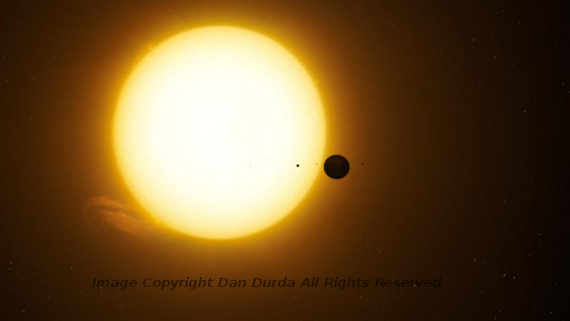
I think the Kepler mission is the most fascinating and inspiring science mission NASA has flying right now. The thousands of planet candidates being discovered are telling us we really do live in a ‘Star Trek’ galaxy full of planetary systems of every variation you can think of.
Since most of my artwork is focused on landscape views of such planets filling the skies of imagined moons orbiting around them, I’m awaiting the day of the first confirmed discovery of such an ‘exomoon’. With this piece I thought I would depict how such a discovery would be made with Kepler. I also wanted to depict the star the way I prefer to think of them in artwork – as brilliantly, blazingly bright. I wanted the viewer to almost feel like the needed to squint a bit to look at it. Of course, no artwork can depict it the way we’d really see it (or, more to the
point, NOT see it because of the blazing star), but I thought we ought to at least invoke that feeling when depicting these things. So, this piece was for the most part an experiment in technique while depicting a favorite subject. Hand ‘painted’ almost completely in Photoshop – the only digital reference was to use some actual imagery of the granulation in the solar photosphere rendered onto a sphere.
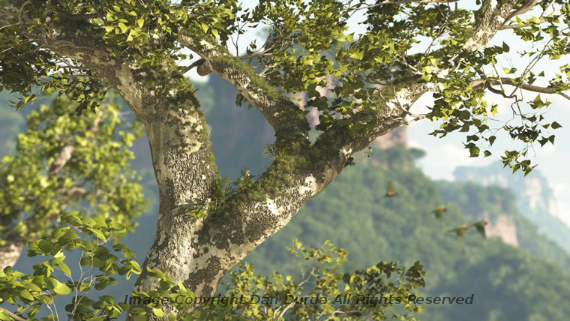
This piece is obviously not space art, but I’m very happy with it. This was another piece done to press myself to learn to drive Vue and to press my digital technique toward as photoreal an effect as I could achieve using purely proceedural digital techniques (i.e., no reference image elements in the piece). The ‘hero’ tree here is a simple Vue ‘Dead Tree’ spieces with an altered ‘Alder Late Spring’ species populated on as an ecosystem layer to provide the branch detail. The moss was added as a second ecosystem layer and a few parasitic plants added to suggest a biologically rich canopy ecosystem. The background terrain trees are an altered ‘Rural
Maple’. The final touch birds were added as an alpha layer to further suggest the rich, living environment in the scene. This scene is the result rendered straight out of Vue – there is no Photoshop postwork here whatsoever.
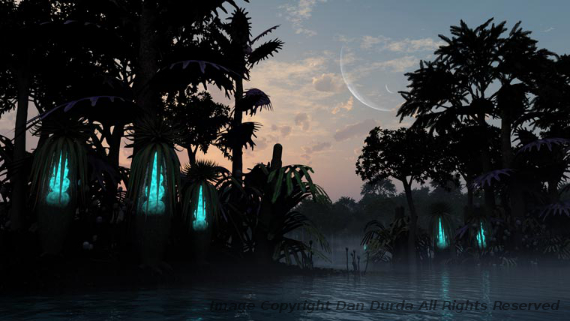
Another scene built, composed, and rendered in Vue. This was one of my first experiments to create a bioluminous effect with luminous materials in Vue. The ‘lava lamp’ planets were modeled in XFrog and then given their luminous materials in Vue. I wanted to try for a misty, humid, pre-dawn swamp feeling for this one and worked to bring in somewhat more ‘alien’ vegetation in the silhouetted trees and plants.

Here’s the story –
https://www.boulder.swri.edu/pkb/stamp/New_Horizons_USPS_Stamp_Petition.html.
The petition stage is over now, so no use signing it at this point, but the good news is that we have enough signatures to have moved on to the next stage of the stamp proposal process!

Way back in 2005 at our IAAA Death Valley workshop I took a series of images on Mars Hill that I assembled into a panorama –
https://www.boulder.swri.edu/~durda/DV2005_pans/slides/Slide20.html.
I always knew I wanted to do something ‘Mars’ with this obviously, but I could never bring myself to start attacking the image to clean it of all the weeds and brush. I’ve learned a thing or two digital art-wise in the years since that workshop and while looking through my reference images for inspiration for another project I came across this panorama and
finally decided to have at it. This image is the result and it is gaining popularity as it is getting around. It is featured in Buzz Aldrin’s new book “Mission to Mars: My Vision for Space Exploration” and was just used near the end of a Tedx talk by Todd May, manager of the
Space Launch System Program office at NASA’s Marshall Space Flight
Center (https://www.youtube.com/watch?v=2xYSwd9bYjY). You can get it on posters, mouse pads, coffe mugs and more at my CafePress store –
https://www.cafepress.com/3dimpact.
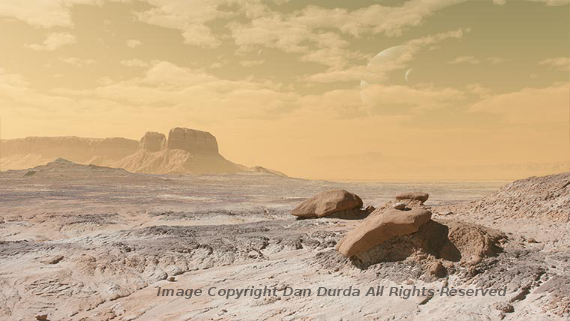
Not all exoplanets are going to be pleasant, jungled oases full of fascinating new biota. I
wanted to depict a barren, desolate world with a noxious atmosphere.
This was another exercise in digital matte paiting, using image elments from digital images I’ve taken in my travels (this time from Goblin Valley in Utah), with substantial portions of the image replaced with digital environment. You can see a ‘before-and-after’ version of this
image (and others) in the ‘mouse over’ gallery on my website –
https://www.3dimpact.com/gallery_mouseover.html.

Crop from an image I made for the cover of a lunar landing site study report that I recently edited for the LPI-JSC Center for Lunar Science and Exploration. One of the motivations for my move to digital was to be able to do the odd ‘hardware’ piece if I felt like it, and pieces like
this are just what I was wanting to be able to have the capability for. I’m beginning to feel more proficient in Modo finally and am loving it more and more the more I learn.

After a number of landscape, ‘matte painting’ style images I was feeling the urge to do
an ‘in-space’ ‘rocks and balls’ (as we call them in the IAAA) view of an exoplanet system. I did this piece almost entirely in Photoshop with only a little help from Celestia for the base planet and moon and Vue for some atmosphere rendering. One thing I wanted to focus on in this
piece was to put a bit more cloud detail onto the planet and moon than I usually do.
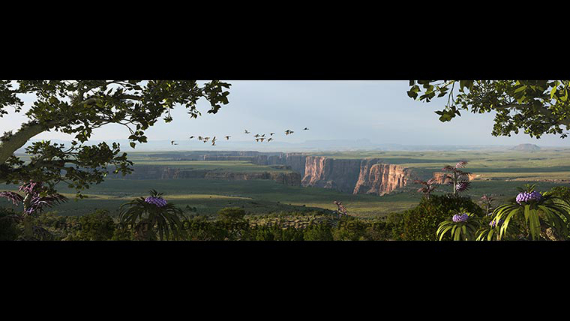
This is another instance of having shot a panorama during one of our IAAA space art workshops and then staring at it for a year before deciding what to do with it. This was a piece I did for myself, just imaging a beautiful alien world I’d love to be able to explore in person. I wanted to create a sense of walking out of some verdant alien woods to discover a vista
overlooking a canyon in the plains beyond. Much of the foreground vegetation and some of the distant landscape rendered in Vue and comped in Photoshop. Some of the alien plants were created in XFrog.
Many thanks to Dan Durda for sharing his enormously exciting career and his artwork with us. You can visit Dan and see more of his art at his personal gallery, at his SwRI Gallery, on Cornucopia3D, check out a bit more on his background at NASA, view even more art at Nova Space Art Gallery, listen to him discuss a huge variety of topics on CoasttoCoast, and even pick up a calendar of his work at Cafe Press.
Once again, thanks to the members of the IAAA for participating in this showcase program.









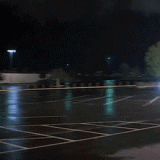

1 Comment